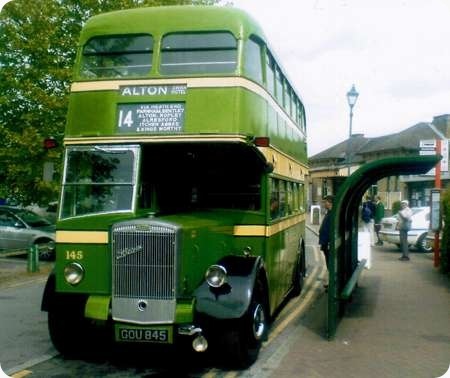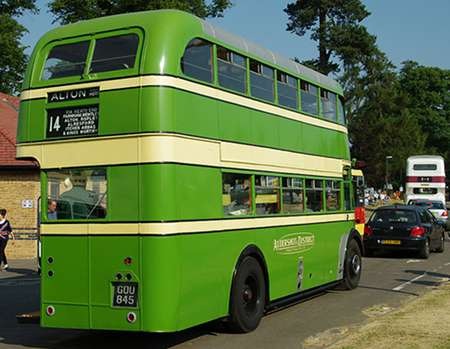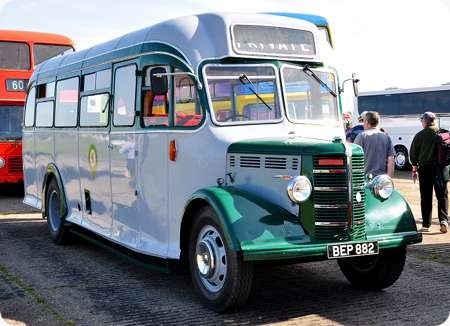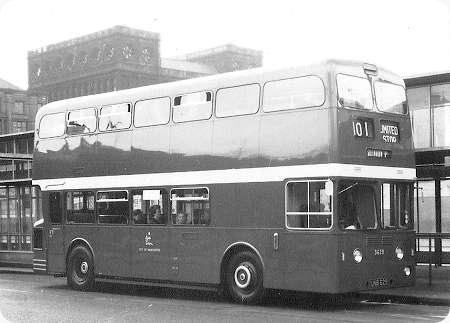
Manchester Corporation
Leyland Atlantean PDR1/1
1959
Metro-Cammell H44/33F
I feel prompted to make a first contribution to your fascinating forum after stumbling across it whilst looking for information concerning the jointly operated Stockport/Manchester Corporations’ Service 16 Chorlton – Stepping Hill.
I was born in Chorlton, attended the grammar school there and recall the day my mother took me for a trip to Stockport on the newly introduced Service 16 on what, to me, was an unusual and interesting single decker with a central exit/entrance. Manchester had no such curiosities (the Royal Tiger ‘Crush Loaders’ with their central doors were still years away and the single deck Leyland (TS5?) used on Service 22 Levenshulme – Eccles was a back loader of sorts.
Little did I know then that I should have the thrill of driving a Royal Tiger on Service 22 myself some 12 or 13 years hence!
All this underlines my love of anything relating to Manchester buses from the period 1958 to 1989 when I finally put my pen away and began drawing my pension. Having worked alongside John Hodkinson in Devonshire Street’s Traffic Office, I was delighted to see his contribution on the piece about jointly operated Service 95/96. In fact it was this that prompted to make contact.
Above is the shiny new Atlantean 3629 at Parker Street on it’s maiden outing, it had spent many weeks in Birchfields Road Garage with the rest of the delivery whilst Union issues were resolved. I remember seeing them there, looking so forlorn, becoming increasingly covered in dust as the weeks dragged by. They had to be put through the wash before going on the road!
Photograph and Copy contributed by David Cooper
10/07/14 – 07:12
David, your piece has brought back many memories of the period when the Evening News had regular articles on the dispute (allegedly sought by management by detailing the vehicles for Northenden depot routes where strong union opposition was expected) and the paper dubbed the vehicles Red Dragons -heaven knows why.
Whilst the majority may have been gathering dust in Birchfields Rd, there were forays driven by management and inspectors. A number of runs were done down Wilmslow Rd during rush hour mornings for some reason, to the bemusement of many a prospective passenger, and one particular day three of the buses were parked at the side of Northenden depot on the public road.
Once the unions and management found agreement the buses entered service on the Wythenshawe routes, then the 50 to Brooklands before moving to Parrs Wood where lower mid panels were often grazed at the tight left turn at the bottom of the ramp!
If I can help with info about the 16 please ask.
Phil Blinkhorn
10/07/14 – 09:55
David I worked with John 1973 – 1975 at Princess Road Depot. Princess Road Depot like so many of the old Manchester Corporation/City Transport depots now gone.
Stephen Howarth
10/07/14 – 11:31
It’s a small world. I too worked with John Hodkinson briefly whilst a Schedules Clerk at Frederick Road, Salford in 1972/73. There were five of us in the Schedules Office – David Broadbent in charge, John, Peter Caunt, George Boswell and myself. I was the lowly junior, the only ‘foreigner’, who commuted every day across from ‘the dark side’ of the moors in Halifax. Incredibly all five of us were enthusiasts, with yet another – the late Keith Healey – working downstairs, it was a wonderful atmosphere to work in – sometimes it seemed more like a hobby than a job. I then took up the position of Traffic Clerk with the Corporation in my home town. It seemed like the right thing to do at the time, but it was the complete opposite of what I had experienced at SELNEC and boy did I quickly come to regret it!
John Stringer
10/07/14 – 14:05
I’ve done that more than once, John, with both musical and teaching posts. When I’ve arrived at the new job, it’s been a poison chalice. "Beware of what you wish for ….."
David Oldfield
11/07/14 – 06:55
John and I have exchanged notes of our experiences in the Halifax Traffic Office. In 1964 I travelled 200 miles to take up that job, but the atmosphere was such that I quit within two years. That was 10 years or so before John gave it a go, so it shows how deep seated was the malaise in the place. The Halifax GM might have been a ‘character’, but the tunnel vision at senior subordinate levels was utterly dispiriting.
Roger Cox
11/07/14 – 06:55
There were also a couple of times when I went out of the frying pan etc………………..also!
Chris Hebbron
11/07/14 – 06:56
Phil, such intimate knowledge of the entrance to Parrs Wood Depot via the ramp suggests to me that you might have had personal experience. You have certainly roused my curiosity, or am I barking up the wrong tree?
The early Fleetlines and Atlanteans were, in my view, nowhere near as enjoyable to drive as a back loader.
Most disturbing factor was the relative absence of sound from the engine. It all seemed and of course was, so remote from the ‘sharp end’. And then there was that awful ‘yaw’ (for want of a better word) that resulted from traversing a series of gullies with the nearside wheels. So much easier to control it when driving a conventional bus.
I never got to drive a GM ‘Standard’. Perhaps they had had all the initial quirks ironed out?
Those names from the Frederick Road Schedules Office certainly took me back, John. I worked with almost all those guys at some stage or other, though left Devonshire Street in 1972, returning in 1974 after a sojourn in the Hotel business. John H. could always be relied upon to provide the answers whenever we Mancunians needed to know something with a Salford bias. And I seem to remember he had an affinity with a certain Devon-based coaching operation!!
I could reminisce all night but I can almost hear the yawns.
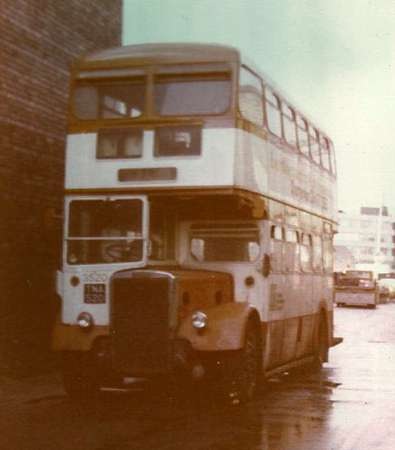
To close, here is a shot taken at the back of Hyde Road Works of 3520 awaiting disposal. She never looked right to me in Selnec livery but was a fascinating bus to drive – usually on Service 1 – Gatley.
David Cooper
11/07/14 – 11:31
David, my knowledge of the ramp at Parrs Wood comes from regular observation over the period from 1958 to 1965 when I would disembark from what was originally the #1 outside the depot to walk across Kingsway to take the #9,#16 or #80 to home on the way back from school. I also had irregular access to the depot through an friend’s neighbour who was an inspector.
3520 looks forlorn in your photo. It looked at its best when on the #1 in original livery, immaculate as Parrs Wood always turned out its star performers, and sounding more like an RT than a PD2.
A few more observations about this batch of Atlanteans. They were delivered with thin, low back seats which were non standard. The rear wheel discs, standard on new deliveries at the time, were absent – probably to the relief of the fitters. Was Albert Neal compensating for the extra weight of the longer bus and higher passenger capacity in his continual fight to keep costs down? Whatever the reason, the next foray into rear engined buses, Fleetlines delivered in 1962, had standard seats and rear wheel discs. The Atlanteans were re-seated with standard seats from withdrawn Burlingham trolleybuses around 1966.
Some drivers complained about the intrusion of both conductors and passengers into their workspace. Another driver complaint was lack of nearside visibility. There were signs instructing passengers not to stand on the platform area, something many did on back loaders after leaving their seat on approach to their stop, but the habit died hard. A more permanent annoyance for the drivers was the door construction with two part windows in each folding leaf, giving a restricted view to the left – and the doors would not open when in gear. The Fleetlines had full length glass in each leaf.
Schoolboys quickly learned where the emergency engine stop was. Located above the bustle on the nearside, it was in reach and many a stop near schools became prolonged until authority in the shape of inspectors and head teachers jointly overcame the problem.
Manchester took a long time to be convinced about the rear engine layout. Combined with the City of Manchester Police’s antipathy to 30ft buses in the city centre, it was nothing short of a revolution when the Mancunian appeared, just ten short years after 3629 and its sisters.
Phil Blinkhorn
13/07/14 – 06:54
Wow, may I join the reunion party please? I also worked at Devonshire Street, with David Cooper, David Broadbent and George Boswell among others. However, I was at the other end of the office, beyond Fred Thomas’s goldfish bowl, wherein he sat smoking his pipe and giggling to himself about the latest traffic absurdity. After three years on the lowest grade I was told that there was no prospect of promotion in the foreseeable future (which I can’t understand now, because we all knew that SELNEC was coming, and that changed everything). Basically it was dead men’s shoes and no-one was thinking of dying, so if you wanted to get on you had to move around. So I moved to Newport, which proved to be my poisoned chalice, and after five months I left the transport industry for good.
The photo of a brand new Atlantean on the 101 stand reinforces a memory I’ll never forget. The 13-year-old me was so gobsmacked by these things that I just stood there while the entire 101 allocation came and went and the first one came back again. I suppose I could have got on one, but I had no idea where Greenbrow Road was.
David, you may like to look at www.sct61.org.uk/index/operator/mn
Peter Williamson
13/07/14 – 09:26
Hi All! Maybe this page should be titled "Old Boys Club"!
Comments have referred to the ramp into Parrs Wood. When the guard-walking-in-front-of-the-bus type smog used to come down, the garage staff used to keep one bay clear inside the depot so the cars that had faithfully followed the bus to find their way home, found themselves inside the depot instead and needed to get out!
John Hodkinson
13/07/14 – 18:22
Peter, that SCT.61 site was new to me (I don’t get out much these days!) and I found it totally absorbing – rather like ‘The Manchester Bus’ but with the superfluous bits left out. Many thanks.
David Cooper
14/07/14 – 07:46
Here’s a link to how 3520 looks nowadays – much happier but evidently suffering from delusions of Hyde Roadness. www.flickr.com/photos/
Peter Williamson
14/07/14 – 09:53
Apart from the blinds, that could be 3520 on any day of its first couple of years in service.
Phil Blinkhorn
14/07/14 – 17:25
Like John I had a "couldn’t believe my eyes" moment when I first saw an Atlantean. It was an exciting day in 1960. I had just passed my "eleven plus" and as a reward my mum bought me my first "Combined volume" loco spotting book. We made the purchase in the city centre when changing buses en route to visit relatives. We just missed the #101, which was one of the usual 44xx Daimlers so we stood waiting for the next one, which turned out to be my first sighting of an Atlantean. On seeing the flat front, my first thought was "How did a trolleybus get away from the wires?" but then I noticed the number – 3627 – so it was obviously a Leyland. And we were going to ride on it, two bits of excitement in one day! I couldn’t wait for our return journey that evening, but to my great disappointment it was just another CVG6. A few weeks later we made another visit, riding on 3630 and 3628, but after that they disappeared from the #101.
In the autumn of 1963 I noticed an occasional Atlantean running through Middleton, my home town, with "special" on the blinds. These were driver training runs before the batch was transferred to Queens Road Garage, at first on the #163 but soon moving to the #121. I became a regular traveller on the #121 in the school holidays, just for the pleasure of riding on these buses. I always went for the inward facing front seat, which offered not only good forward vision but also a chance to watch the driver.
In later life, some of the batch had minor differences. 3621 had "LEYLAND" spelt across the rear bonnet in separate letters (I believe this one also had an O.680 engine at one point), 3626 had a much newer steering wheel with a slightly different design, and our friend 3629 was only a 77 seater while all the others seated 78, the difference being the inward facing front seat which was a treble on most of the batch, but a double on 3629. Finally, 3624 was the only example to receive Selnec livery.
Eighteen months later Queens Road Depot got the first of the PDR1/2 Atlanteans (3721-35) for the #163, but these were very different sounding, thanks to their Daimler gearboxes.
Don McKeown
